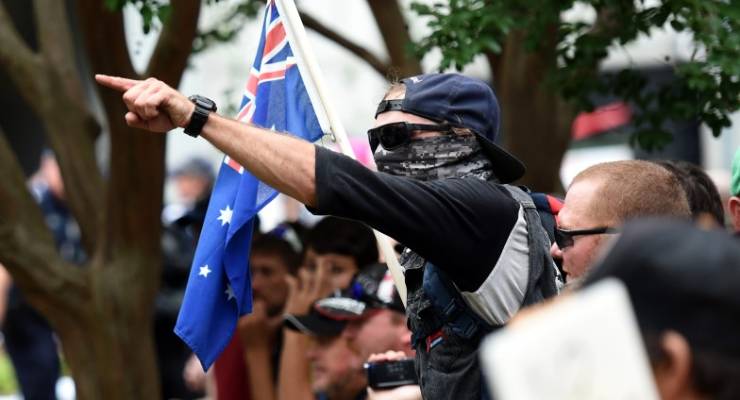
On March 14 2019, a new post appeared on the 8chan politics board /pol/. “Well lads”, it read, “it’s time to stop shitposting and time to make a real life effort post. I will carry out and [sic] attack against the invaders, and will even live stream the attack via Facebook.”
The post linked to the Facebook page of a 28-year old Australian man and a 74-page manifesto entitled “The Great Replacement”. “[P]lease do your part by spreading my message, making memes and shitposting as you usually do,” it continued.
At 1.40pm the next day, a man arrived at the Al Noor Mosque in Christchurch, New Zealand, during Friday prayers. A worshipper greeted him with, “Hello, brother” — and the stranger opened fire.
Unfortunately, the bullets that took the lives of 51 people didn’t come out of nowhere.
Recent statistics show right-wing violence on the rise. The Center for International and Strategic Studies reports that terror attacks from far-right perpetrators doubled between 2016 and 2017 in the United States, and grew by 43% in Europe in that same period.
Between 2009 and 2018, according to the Anti-Defamation League, extremists from the right caused 73% of US domestic terror deaths, compared to 23% of deaths attributed to Islamists and 3% to left-wing terrorists. The only reason rightists didn’t have a monopoly over the fifty deaths from domestic terrorism in 2018 was that one attacker abandoned white supremacism for radical Islamism prior to committing murder.
The alleged perpetrator of the Christchurch massacre might have entered the mosques by himself but, politically, he was never alone. We know that, after growing up in the regional town of Grafton in New South Wales, the accused man used inherited money to travel through Europe — and on those trips he interacted with far-right organisations in many different countries.
We also know that he was deeply invested in the Australian fascist movement. On a secret blog frequented by activists from the far right, Tom Sewell, a leading fascist activist, acknowledged that the alleged perpetrator “had been around” the so-called patriot movement since before 2016.
“He was well known”, Sewell explained to his co-thinkers, “for those in the know”. A future mass murderer was “well known” to other fascists — and none of them did anything to stop him. While Sewell and other activists distanced themselves from the massacre, some posters on platforms such as 8chan and Gab openly applauded the violence — and others called for more killings. That’s why we must understand the alleged perpetrator’s ideas, however repellent they are.
I’ve chosen to refer to the accused killer as Person X. Certainly, many will find a discussion about the hateful doctrines that inspired Person X difficult. It would be wrong to make that process more painful. In any case, the euphemism serves another purpose, emphasising a key argument of this book. The Christchurch gunman emerged from a fascist subculture in which he’d previously been a minor and anonymous figure. Before he stepped into the limelight to shoot innocent people, no one — outside the milieu of the far right — knew who he was. The next killer will be the same.
Person X nominates in his manifesto Sir Oswald Mosley as “the person from history closest to my own beliefs” — and because Mosley’s career straddled the pre-war and post-war era, he provides a useful illustration of the evolution of 20th-century fascism. Oswald Mosley was born in 1896 into an aristocratic Staffordshire family that blamed its reduced influence on a nefarious modernity.
He first won a parliamentary seat in 1918 as a Conservative, became an independent in 1920, and then, in 1924, joined the Labour Party. In 1931, he launched his own New Party, which gave way to the British Union of Fascists (BUF), an organisation explicitly putting forward an anglicised interpretation of ideas borrowed from Mussolini and (later) Hitler.
For a period, the BUF seemed poised for a break-through. At its peak, it had a membership of about 50,000 people. It briefly enjoyed the support of establishment figures such as the press baron Lord Rothermere, who backed fascism in Britain (as he had in Italy) as a counter to the communism he loathed. The group founded its own Black House (in imitation of Hitler’s Brown House), where its members studied martial arts and performed paramilitary drills.
Over time, the BUF became overtly anti-Semitic. As the conflict in Europe drew closer, Mosley argued for appeasement, declaring “a million Britons shall never die in your Jews’ quarrel”. Mosley himself was arrested, and spent the rest of the war in prison.
After his release from prison, he set about reconstructing an English-speaking fascism for the post-war era, in terms that still resonate today.
The BUF ’s agitation against Jews in Britain bears no direct relevance for an Australian fascist living in New Zealand. But Mosley’s later doctrine presented “Europeanism” as an expansive category, a political ideal as much as a geographical identification. In a similar fashion, Person X could write about defending “our lands” against “invaders”, even as he stood on the soil that Māori called Aotearoa.
Mosley represents a link between the “glamour” of the classical era and the strategies of tiny far-right grouplets today — organisations that present comparable ideas, albeit to a much-reduced constituency. Sir Oswald was the handsome playboy who married Diana Mitford in Goebbels’ drawing room (at a ceremony attended by Adolf Hitler); he was also the post-war leader of a fringe sect campaigning against immigrants while trying to recruit teenage thugs. He embodies fascist continuity — linking, however tenuously, the age of Hitlerism to the misfits attracted to neo-Nazi groups today.
This is an excerpt of Jeff Sparrow’s Fascists Among Us, published November 19 by Scribe Books.








To use a personal health analogous, often we worry about germs and viruses that can make us sick. We wash our hands and practice good external hygiene. But, now we know that cancer screening and heart checks are also needed to watch for those internal conditions that can just as easily make us ill and/or kill us. Christchurch was the hard lesson for us in Australia and New Zealand. We now must practice ever more detailed internal inspections to keep our communities healthy and to avoid corrosive cancers that can strip away our social health. We must accept the need for these internal exams and ensure the professionals we charge with this responsibility are well legislated for, well trained, well resourced and well respected for the ‘pathology’ work they do on our collective behalf.
I wish you were right Richard, but I think our spies are either incompetent or malicious, and will only use the vast pile of our data they collect to abuse us or our brave whistleblowers, and protect their fascist master’s arses, rather than actually protecting us from these murderous nutbags.
Evidence so far would suggest that small teams focused on the nutjobs in plain sight would do a better job of protecting us.
Surely it can’t be that hard to monitor these hate platforms directly, rather than collecting vastly more data than they will ever have the manpower to analyse properly.
Yes, that is definitely what is wrong with that idea. Lol.
I fully support those who are charged with the act of uncovering any form of terrorist risk or any other form of criminal activities which effects the life or health of the citizens, the nations infrastructure, or the states infrastructure. I believe that whenever there is a warrant issued to pursue a beleath of criminal activity, that warrant MUST be open to scrutiny and the reasons for the request must also be made public. This is allowing for the removal of names, and other security sensitivity facts removal.
Jeff. I refer you to Eatwell, R. and Goodwin, M.: “National Populism: The Revolt Against Liberal Democracy”
Although ‘fascism’ has some common characteristics with our present far-right politics, calling them fascist on the basis of a single policy or characteristic is inaccurate.